This
department displays compasses
for religious and esoteric use. We will try to describe their aim and
use.
Please be patient - or ... help us and send us your own inputs if
you want to participate in this project. Many thanks in advance.
Magnetism as discovered by the ancient Chinese is being
described in many books, especially in
The
riddle of
the compass, by Amir D. Aczel,
2001.
They
used it mainly for divinatory purposes. They traveled mainly on rivers
where a compass is not required. Even if sailors used a compass
to navigate far away from the coast, this knowledge was kept
secret since it gave their possessors an edge over the competition. As
far as we know they mastered the technique since the begining of our
time era. Unfornately, as it happened many times at several places in
the world, the catholic church organized the destruction of many
archives and the technical and historical information was not conveyed
to us.
The various ways of dividing
the horizon circle
Depending on the context, the Chinese (and the Japanese?) have used
various systems of dividing the horizon surrounding them.
In the ancient Chinese astronomy, the cardinal points were
described by symbolic animals and colours:
-
North:
black turtle
-
East:
blue dragon
-
South:
red bird
-
West:
white tiger
The
description started
with the rising
sun in the East clockwise finishing with the North. These
directions also had a room-time-related meaning:
-
Toung
(East) was also called
Chang,
i.e. the upper side,
-
Nan
(South) was also called
Thsian,
i.e. the fore side,
-
Si
(West) was also called
Hia,
i.e. the lower side,
-
Pé
(North) was also called
Heou,
i.e. the back side.
The positions between these four main cardinals were
designated by the combined names.
Example:
Toung
nan
= South-East. These eight directions were also replaced by the
eight trigrammes called
kwa
(see below astrological compass or
Luo
pan)
There were further divisions in 12*, 16 or 24 rumbs.
The 24 signs partition was used for
nautical
compasses (see example and explanations in this section). The
12 signs partition was used in Japan.

The 12 signs on the back of turtle
Technical Data
- Dimensions: 100 x 70 x 40 mm
- Weight: 120 gr
|
The 12
signs on the face of a Japanese pocket compass

The 12
signs as described in Klaproth's booklet (in the inner circle:
the 4 card.
pts.):

|
Phonetic
value, translation and
resulting angle:
1 - TSU
(rat): north
2 - Tcheou (ox): north 1/3 east
3 - In (tiger): north 2/3 east
4 - MAO
(hare): east
5 - Chîn (dragon): east 1/3 south
6 - Szu (snake): east 2/3 south
7 - OU
(horse): south
8 - Wei (sheep): south 1/3 west
9 - Chin (ape): south 2/3 west
10 - YEOU
(chicken): west
11 - Siu (dog): west 1/3 north
12 - Haï (pig): west 2/3 north
These signs can be combined so as to build 16
directions by dividing each quarter of the full circle in four parts.
Example: Mao
chîn =
east-south-east
|
Luo Pan Compass

Traditional Luo Pan compass
(19th c.)
Click
on the
picture
for a full screen display |
The astrological Chinese
compass as described by Klaproth in his famous Lettre
à M.
le Baron A. de Humbodt sur l'invention de la boussole
(1834)
Link: The
Luo-Pan in A.
Schück's book Der
Kompass (vol.
2, 1915)
|
Technical
Data
- Diameter: 105 mm
- Depth: 11 mm
- Weight: 150 gr
In the first of the 15 concentric circles
surrounding the
compass, the eight basic directions are represented by three-lines
symbols called trigrams or kua of Fu
Xhi.

Table above: the 8 Kua
(at left: Klaproth's study;
at right: Wikipedia)
|
Inclining
Sundial
Description of the sundial panel and the compass's
surrounding area based on the explanation given in J.
Klaproth's
famous booklet
Lettre
à M. le Baron A. de Humboldt,
1834 (online
HERE):
- The Adjustable Panel (sundial):
Above the gnomon: one illegible character; below the
gnomon, the sign "
bei"
(north) and three concentric circles :
- Inner circle: the 12 signs
cycle
- Middle circle:
figures 1-12, repeated twice,
clockwise.
- Outer circle: (?)
- The Compass's surrounding Area (three concentric circles):
- Inner circle: the
eight kua
or trigrammes of Fou Xhi (compare with
the instruments above).
- Middle circle: the same in
classical characters (N-W in
red).
- Outer circle:
the 24 Tcheou
cycle (see cat. NAUTICAL
compasses).
Description The
compass
has a grey
metal base on which the meridian line is marked. It has a steel needle,
reddened at its South end, and is covered by a glass plate, held in
place by a black ring. Beneath the hour-plate is a toothed ratchet
scale with 13 divisions, marked in black. A brass strut attached to the
back of the hour-plate is set in this scale to position the hour-plate.
The front has an hour scale for Chinese hours. Two red characters
within this scale indicate that the compass should be turned to the
North. There is a brass rod gnomon that folds flat when not in use, to
be set perpendicular to the hour-plate. On the reverse side of the dial
are nine Chinese characters (three in red) giving the name of the maker
and the area from which he came.

Technical
Data
Material: wood, lacquered
Dim.: 120 x 58 x 18mm
|

|

On
either side of the
13 notches appears the 24 divisions of the chinese sun calendar (二十四节气
Èrshísì
jiéqì). Two are
repeated (hence 13). The first and last represent the solstices and the
middle one the equinoxes. Around this list are four
signs in red ink ( 四序調元 ) meaning "the four seasons in harmony with
the
original Qi ". This is not a person's or an
animal's Qi but
the one of a place during a certain season.
|
|
Qibla Compasses
Wherever they are in the world, Muslims must turn to their Holy City
(Mecca, Saudi Arabia) for their ritual prayers. This
direction is called the
qibla
and
is
represented in mosques by a niche in a wall called the
mihrab.
The compasses described thereafter show the right direction.
The Arabs had already been using compasses to this aim in the
13th century, i.e. before the crusades, and this knowledge was
transmitted to the West about at this time. For more
information read
TWO
EARLY ARABIC SOURCES ON THE MAGNETIC COMPASS
(full text available, pdf).
The German Institute for History of Arab-Islamic Science (Institut
für die Geschichte der
arabisch-islamischen Wissenschaften) in Frankfurt/M. displays in its
virtual museum reproductions of ancient compasses cited in the
above-mentioned document. For pictures of al-Ashraf
Umar's
compass, click first
HERE,
then select
Museum,
then
"8
- Nautik".
This item looks like a
Butterfield-type
sundial
but features no hours chapter on which the shadow of the animal-shaped gnomon would point.
Moreover, zodiac signs engraved in a circle on the face
suggest it
was rather intended for an astrological use or to find the Qibla. A freely
rotating pointer is attached at the center of the face where
the gnomon rotates.
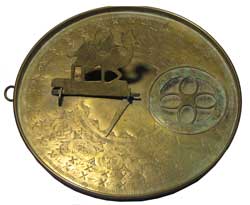 |

|
Probably
genuine instrument
featuring a camel-shaped gnomon
- Dia. 6¾" / 172 mm
- Engravings on rear face ?
NOTE - Many items are only replicas
which you can easily tell when looking at the modern compass needle
Pictures
courtesy
antique-scientific-instruments
|
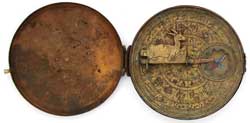
Pictures courtesy J.
Grobovsek
(Click on the images for enlarged views) |

|
Technical
Data
- Dia. of case: 4" / 105mm
- Dia. of compass: 25mm
- Thickness: 1" / 23 mm
- Gnomon: goat
- Engravings on face: zodiac signs (conventional
symbols and full name in Arabic language)
- Engravings on rear face: see pic at right
- Engravings on lid: click HERE |
Rear face

|
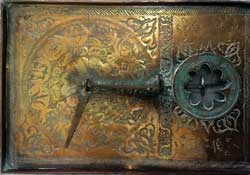
|
 |
Top
face with gnomon and compass featuring zodiacal symbols and Arabic words
Rear face engraved |
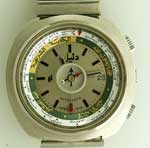
Another interesting instrument is this watch with compass described in
the section "
Watches
with a
compass"

"KOSHER" COMPASS
Compass working like the ones above but indicating the direction of
Jerusalem.
Pendulum with Compass
Description : This instrument was most probably used
for spiritualism. When the medium holds the electrode
at the
end of the wire and the pendulum is hanging over a photograph (for
example) of a beloved person, the magnetic needle points then towards a
direction corresponding to the feelings of the person on the
photograph. The indicated values are the same as on the
postcard,
i.e.
cool in the North but hot in the South. By placing a
magnet
under the table and the photograph accordingly on the table, you can
achieve very good results...

Pictures
by courtesy of
Arlete
Anderson
(Click on the pictures for enlarged views) |

Markings (on side):
Registr. 8548 K K Berlin
|
Technical
Data
- Diameter (compass): 1 1/4" - 32 mm
- Height (pendulum alone): 2 3/4" - 70 mm
- Case: 5 x 2 1/2 x 2" - 270 x 68 x 5 mm
- Weight: 1.6 oz - 36 gr
- Electrodes: cylindrical rods, flattened at the end like
screw-drivers, connected via a metallic wire, wrapped around the
pendulum's
"waist".
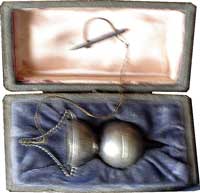
The instrument in a luxurious case with silk cushions |








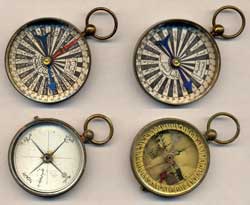
 Robert PRETOT filed
in 1952 a patent
(no. 1,054,674 completed in 1955) for a
modernized Qibla compass. Several versions were described (see images at r., full text
available).
Robert PRETOT filed
in 1952 a patent
(no. 1,054,674 completed in 1955) for a
modernized Qibla compass. Several versions were described (see images at r., full text
available).






